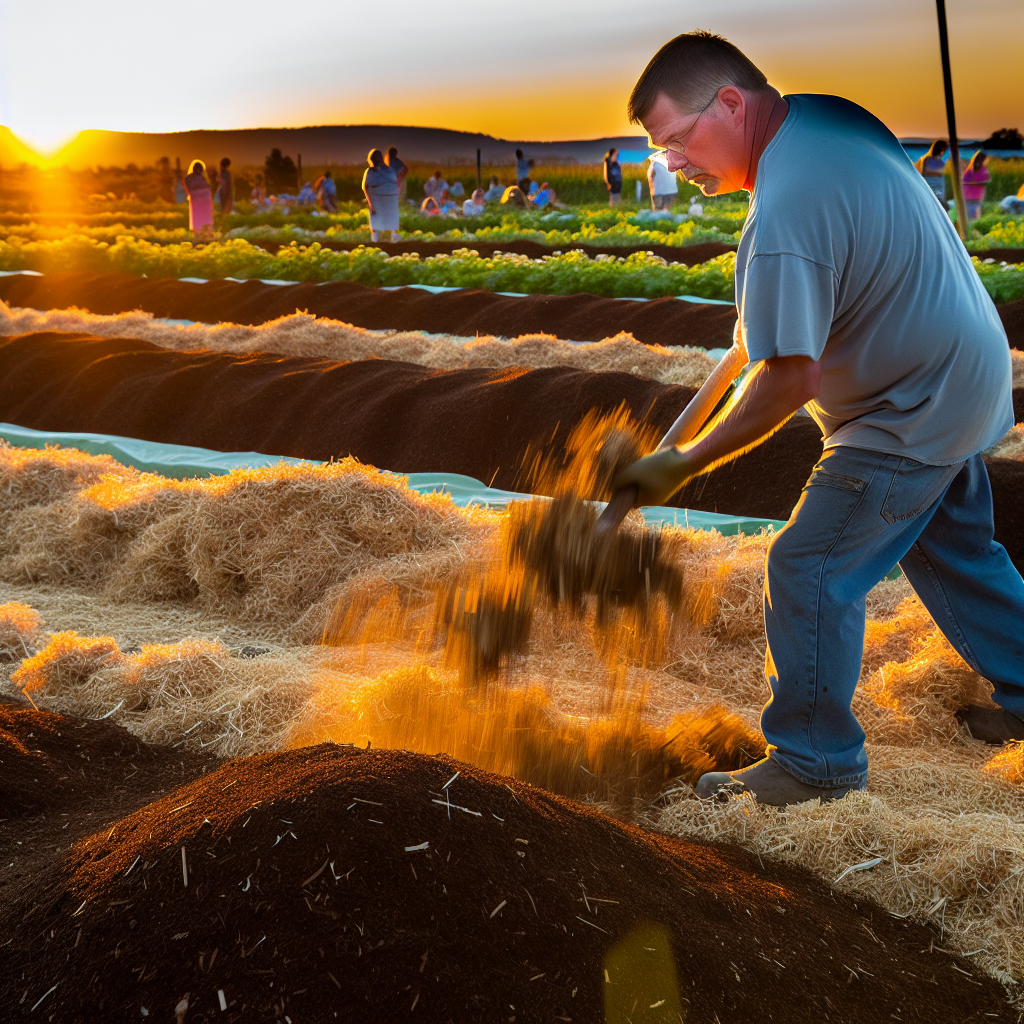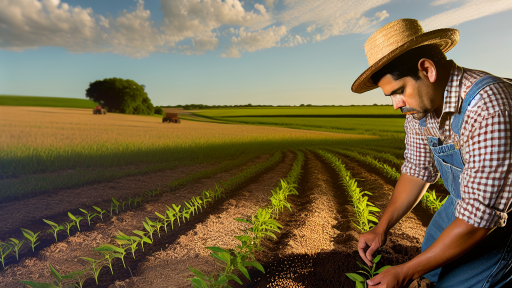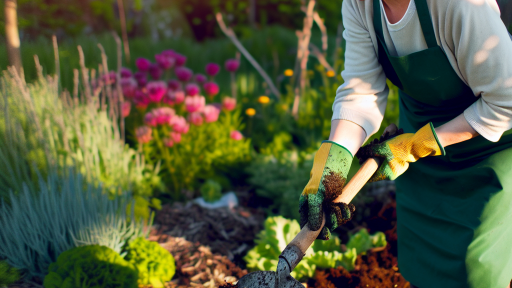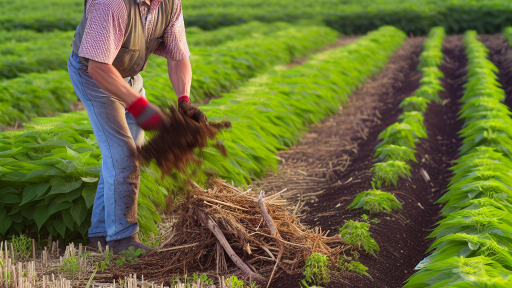Introduction to Soil Health and Its Importance for Sustainable Agriculture
Soil health is vital for sustainable agriculture.
It directly influences crop productivity and ecosystem balance.
Healthy soil fosters nutrient availability and promotes plant growth.
Moreover, it supports beneficial organisms and enhances biodiversity.
Key Aspects of Soil Health
Several factors contribute to overall soil health.
These include soil structure, organic matter content, and microbial activity.
Well-structured soil improves water infiltration and root penetration.
Organic matter, like compost or mulch, enriches the soil with nutrients.
Additionally, active microbial communities decompose organic materials efficiently.
Soil Health and Environmental Impact
Healthy soil plays a crucial role in environmental sustainability.
It helps reduce erosion and filter pollutants.
This natural filtration system protects water quality in nearby bodies.
Healthy soils also store carbon, mitigating climate change effects.
Thus, investing in soil health leads to ecological benefits as well.
Challenges to Soil Health
Modern agricultural practices often threaten soil health.
Transform Your Agribusiness
Unlock your farm's potential with expert advice tailored to your needs. Get actionable steps that drive real results.
Get StartedOveruse of chemical fertilizers leads to nutrient imbalances.
Additionally, monocropping depletes organic matter over time.
Deforestation and overgrazing can also degrade soil quality.
Addressing these challenges is vital for sustainable farming practices.
Implementing Sustainable Practices
Utilizing sustainable techniques enhances soil health over time.
Crop rotation diversifies nutrient usage and reduces pest buildup.
Cover cropping protects soil from erosion and adds organic matter.
Conservation tillage minimizes soil disturbance and promotes structure.
Each practice contributes positively to the overall health of the soil.
The Role of Mulching in Soil Health
Mulching is a strategic method to improve soil health.
It helps in moisture retention and temperature regulation.
Additionally, mulch suppresses weeds, reducing competition for resources.
Organic mulch contributes nutrients as it decomposes over time.
Implementing mulching techniques enhances the sustainability of agricultural systems.
What is Mulching?
Definition
Mulching involves covering the soil surface around plants.
This practice protects and enriches the soil.
It helps retain moisture and suppress weeds.
Moreover, mulch adds organic matter to the soil.
Overall, mulching promotes healthier plants.
Types of Mulch
There are various types of mulch available.
Organic mulches include materials like leaves, straw, and wood chips.
These materials decompose, enriching the soil over time.
Inorganic mulches consist of materials such as gravel and plastic.
These do not decompose and provide long-lasting coverage.
Showcase Your Farming Business
Publish your professional farming services profile on our blog for a one-time fee of $200 and reach a dedicated audience of farmers and agribusiness owners.
Publish Your ProfileBenefits of Organic Mulch
- Improves soil fertility.
- Enhances soil structure.
- Encourages beneficial microorganisms.
Benefits of Inorganic Mulch
- Reduces soil erosion.
- Helps control soil temperature.
- Requires less maintenance compared to organic options.
Choosing the Right Mulch
Selecting the appropriate mulch depends on several factors.
Consider the type of plants and the local climate.
For example, heavier mulches suit perennial gardens well.
Light mulches work better in annual flower beds.
Ultimately, the right choice enhances overall garden health.
The Role of Mulching in Enhancing Soil Structure and Fertility
Understanding the Importance of Soil Health
Soil health is fundamental for productive agriculture.
Healthy soil supports plant growth by providing essential nutrients.
Moreover, it retains moisture and fosters a thriving ecosystem.
What is Mulching?
Mulching involves covering soil with organic or inorganic materials.
This practice protects soil from erosion and temperature fluctuations.
Furthermore, it minimizes weed growth, ensuring better crop yields.
Types of Mulch
- Organic Mulch: This type includes materials like straw and wood chips.
- Inorganic Mulch: Common materials are plastic and gravel.
- Living Mulch: Ground cover plants serve as a natural mulch.
Enhancing Soil Structure
Mulching significantly improves soil structure over time.
Organic mulches break down, adding valuable organic matter.
This process increases soil aggregation, making it more resilient.
Improving Soil Fertility
Mulch contributes to soil fertility by adding nutrients as it decomposes.
This slow release of nutrients supports continuous plant growth.
In addition, it promotes beneficial soil microorganisms.
Retaining Moisture
Mulching plays a crucial role in moisture retention within the soil.
It reduces evaporation by covering the soil surface effectively.
Consequently, plants have access to water for longer periods.
Preventing Soil Erosion
Soil erosion can undermine agricultural productivity.
Mulch acts as a protective barrier against wind and rain.
This layer minimizes soil loss and maintains soil quality.
Promoting Biodiversity
Using mulch fosters a diverse ecosystem within the soil.
Beneficial insects and microorganisms thrive in mulched areas.
Such biodiversity is essential for a balanced agricultural environment.
Discover More: Sustainable Practices for Post-Harvest Processing
Benefits of Organic vs. Inorganic Mulch: A Comparative Analysis
Understanding Organic Mulch
Organic mulch consists of natural materials like leaves, straw, and wood chips.
This type of mulch breaks down over time, enriching the soil.
Additionally, it enhances soil structure and promotes healthy microorganisms.
Organic mulch also conserves moisture and suppresses weed growth effectively.
Advantages of Organic Mulch
Organic mulch improves soil fertility through decomposition.
As it breaks down, it releases nutrients vital for plant growth.
Moreover, it encourages beneficial insects, such as earthworms and pollinators.
This type of mulch supports a diverse ecosystem in the garden.
Understanding Inorganic Mulch
Inorganic mulch includes materials like gravel, plastic, and rubber.
It does not decompose and often provides lasting coverage for soil.
Inorganic mulch is effective for controlling weeds and retaining moisture.
However, it can lead to soil temperature issues if not used properly.
Advantages of Inorganic Mulch
Inorganic mulch offers durability and longevity in garden applications.
Showcase Your Farming Business
Publish your professional farming services profile on our blog for a one-time fee of $200 and reach a dedicated audience of farmers and agribusiness owners.
Publish Your ProfileIt requires less maintenance over time due to its non-decomposing nature.
This type of mulch can reduce soil erosion and prevent compaction.
Additionally, it is useful for ornamental areas and pathways.
Comparative Summary
Both organic and inorganic mulches have their unique advantages.
Organic mulch enriches soil health while creating a healthy ecosystem.
In contrast, inorganic mulch offers durability and lower maintenance needs.
Deciding between them depends on garden goals and environmental impacts.
Explore Further: Using Technology to Enhance Post-Harvest Management
How Mulching Affects Soil Moisture Retention and Temperature Regulation
Introduction to Mulching
Mulching is a useful practice for enhancing soil health.
Gardening and agricultural experts widely recommend it.
This technique improves soil moisture retention significantly.
Moreover, it regulates soil temperature effectively.
The Role of Mulch in Moisture Retention
Organic mulches are particularly effective in conserving moisture.
They create a barrier that reduces evaporation from the soil surface.
Thus, plants receive water for a longer period between rainfall or irrigation.
In addition, mulch prevents soil crusting.
This enhanced structure allows water to penetrate more easily.
Consequently, roots can reach moisture more efficiently.
Temperature Regulation Benefits
Mulching plays a critical role in maintaining soil temperature.
It keeps the soil cooler during hot summer months.
This cooler temperature promotes better root growth.
Furthermore, in cooler seasons, mulch acts as insulation.
It helps keep the soil warmer and protects plant roots.
Such thermal regulation can lead to healthier plants.
Selecting the Right Mulch Material
Choosing the appropriate mulch material is essential.
Organic options include straw, wood chips, and grass clippings.
These materials break down over time, enriching the soil.
Conversely, inorganic mulches, like rocks, do not decompose.
They are excellent for long-term moisture retention but offer no nutrients.
Implementing a Mulching Strategy
To maximize benefits, apply mulch correctly.
Layer the mulch to a depth of about three to four inches.
This thickness offers optimal moisture retention and temperature control.
Avoid mounding mulch directly against plant stems.
Doing so can lead to disease issues.
Instead, keep mulch a few inches away from stems and trunks.
Monitoring and Maintenance
Regularly check the effectiveness of your mulch layer.
Over time, materials decompose and need replenishing.
A consistent inspection schedule ensures that benefits remain intact.
Adjustments can enhance moisture retention and soil temperature management.
Uncover the Details: Preventing Soil Erosion in Organic Farming Systems
Showcase Your Farming Business
Publish your professional farming services profile on our blog for a one-time fee of $200 and reach a dedicated audience of farmers and agribusiness owners.
Publish Your ProfileStrategic Mulching Techniques for Different Soil Types and Crops
Understanding Mulch Types
Mulch comes in many forms, including organic and inorganic materials.
Organic mulch consists of materials like straw, wood chips, and leaves.
Inorganic options include plastic, fabric, and stone.
Each type serves distinct purposes for soil enhancement.
Applying Mulch to Different Soil Types
Sandy soils benefit from organic mulch, which retains moisture.
Additionally, it provides nutrients as it decomposes.
Clay soils require specific techniques for effective mulching.
In this case, using shredded leaves helps improve aeration.
Loamy soils, being well-balanced, can benefit from various mulch types.
Using Mulch for Various Crops
Different crops thrive under specific mulching practices.
Vegetable gardens often require a thick layer of organic mulch.
This helps suppress weeds while maintaining soil temperature.
Fruit trees, on the other hand, benefit from a wider mulch circle.
This encourages deep root growth and moisture retention.
Seasonal Mulching Strategies
Implementing seasonal strategies can enhance mulching effectiveness.
For example, applying mulch before winter protects soil from freezing.
In the spring, clear any old mulch to allow new growth.
Rotate mulch types based on soil and weather conditions.
Best Practices for Mulching
Ensure a layer of 2 to 4 inches of mulch for optimal results.
Keep mulch away from plant stems to prevent rot.
Regularly monitor mulch thickness and replenish as needed.
Additionally, consider using mulch that matches your aesthetics.
Common Mistakes to Avoid
Avoid using large chunks of mulch that restrict water flow.
Steer clear of toxic materials such as rubber or treated wood.
Lastly, do not neglect regular maintenance of your mulched areas.
Gain More Insights: Choosing the Best Mulch Materials for Your Farm

Best Practices for Applying Mulch
Timing for Application
Apply mulch at the right time to maximize its benefits.
Spring is an excellent season for fresh mulching.
This timing helps suppress weeds early in the growing season.
Fall mulching can protect plants from harsh winter conditions.
Consider local climate conditions when timing your application.
Choosing the Right Thickness
The thickness of the mulch layer impacts its effectiveness.
A thickness of two to four inches is generally ideal.
Too thin a layer may not suppress weeds effectively.
On the other hand, overly thick mulch can suffocate plants.
Monitor moisture levels to adjust thickness accordingly.
Selecting Mulch Materials
The choice of mulch material affects soil health.
Organic mulches, like shredded bark or straw, enrich the soil.
Inorganic options, like gravel, provide long-lasting coverage.
Consider factors such as aesthetics, cost, and availability.
Showcase Your Farming Business
Publish your professional farming services profile on our blog for a one-time fee of $200 and reach a dedicated audience of farmers and agribusiness owners.
Publish Your ProfileExperiment with different materials to see what works best for your garden.
Maintaining Mulch Layers
Regular maintenance keeps your mulch layer effective.
Add fresh mulch annually to maintain thickness and nutrition.
Periodically check for decomposition, especially with organic types.
Rake and fluff the mulch to improve aeration and moisture retention.
Remove any weeds that may penetrate the mulch barrier.
Challenges and Considerations
Potential Downsides of Mulching
Mulching can sometimes lead to weed growth.
Weeds may thrive in organic mulches if not managed properly.
Additionally, excessive moisture retention can occur.
Too much moisture can cause root rot in susceptible plants.
Some mulches might harbor pests or diseases.
Pests can be attracted to the organic material used.
Furthermore, certain mulch materials may alter soil pH.
Changes in soil pH can affect nutrient availability.
Moreover, mulching can be labor-intensive initially.
Applying and maintaining mulch requires time and effort.
Choosing the Right Mulch
Consider your specific gardening goals when selecting mulch.
Different materials serve different purposes in the garden.
Organic mulches improve soil structure as they decompose.
In contrast, inorganic mulches provide long-lasting coverage.
Evaluate your garden’s location for appropriate material.
Areas with high rainfall may require quick-drying choices.
On the other hand, shaded areas often benefit from moisture-retaining mulches.
Research the potential impacts of each mulch type.
Understanding these impacts can reduce unforeseen issues.
Lastly, always monitor your garden post-mulching.
Assess both plant health and mulch condition regularly.
Case Studies: Successful Implementations of Mulching for Soil Health Improvement
Organic Farm Case Study
Green Leaf Organic Farms improved their soil health through innovative mulching practices.
By using straw as mulch, they increased moisture retention significantly.
This led to a reduction in irrigation needs by 30% during the dry season.
Furthermore, pests declined due to reduced soil exposure.
Besides, they noticed enhanced organic matter decomposition, enriching soil nutrient levels.
Community Garden Initiative
The Riverside Community Garden adopted wood chips as a mulching material effectively.
They observed a remarkable decrease in weed growth across the plots.
This practice encouraged local biodiversity by attracting beneficial insects.
Moreover, the wood chips improved soil structure over time.
As a bonus, volunteers appreciated the aesthetic appeal of the garden.
Research Farm Implementation
Harvest Fields Research Farm conducted a study on mulching with leaf litter.
Their findings showed enhanced earthworm populations in mulched areas.
Earthworms contribute to aeration and nutrient cycling in the soil.
Showcase Your Farming Business
Publish your professional farming services profile on our blog for a one-time fee of $200 and reach a dedicated audience of farmers and agribusiness owners.
Publish Your ProfileIn turn, this resulted in increased crop yields by 15% in controlled tests.
Additionally, they noted improved soil pH balance, promoting better plant growth.
Urban Gardening Project
The Urban Oasis Project successfully utilized recycled paper as mulch.
This initiative reduced waste while supporting plant health in inner-city gardens.
Participants reported easier gardening tasks due to less weed competition.
Furthermore, the project helped inspire community involvement in sustainable practices.
The adoption of paper mulch fostered environmental consciousness in the neighborhood.
Homeowner Examples
Local homeowners often use grass clippings as an effective mulching material.
The clippings suppress weeds and maintain soil moisture levels effortlessly.
Additionally, they enrich the soil as they decompose completely over time.
Many residents enjoy easy access to resources from their own lawns.
Consequently, this approach results in cost savings and environmental benefits.
Future Trends: Innovations in Mulch Materials and Techniques
Emerging Mulch Materials
Innovative materials redefine mulching practices.
Biodegradable plastics offer an eco-friendly alternative.
These materials decompose, enriching the soil naturally.
Tests show they enhance moisture retention effectively.
Additionally, mycelium-based mulch supports soil health.
This organic option promotes beneficial microbial activity.
Advancements in Application Techniques
New technologies improve mulch application efficiency.
Automated systems reduce labor and increase precision.
Drones facilitate even distribution of mulch over crops.
Such innovations minimize soil disturbance during application.
Moreover, real-time sensors monitor moisture levels accurately.
Integration with Smart Farming
Smart farming practices incorporate mulch strategically.
IoT devices optimize mulch usage based on environmental data.
This integration supports more precise agricultural strategies.
Farmers can respond quickly to changing conditions.
Furthermore, data analytics provide insights for better planning.
Environmental Sustainability Considerations
Environmentally friendly mulching methods gain traction.
These methods significantly reduce chemical inputs in agriculture.
They also encourage carbon sequestration in the soil.
As a result, biodiversity in agricultural landscapes improves.
Farmers increasingly recognize these ecological benefits.
Additional Resources
NRCS Climate-Smart Mitigation Activities | Natural Resources …




